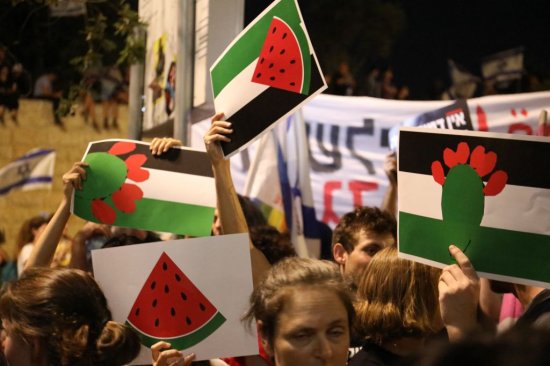
When Palestinian flags are banned or censored, activists and allies use the watermelon as a symbol of resistance.
The mighty watermelon—whether held in hand, depicted in art, or posted online as an emoji—is a powerful symbol for Palestinians.
The fruit has once again cropped up on countless social media posts, in the wake of the Israel-Hamas war begun by a surprise Hamas attack that left 1,400 people dead in Israel. At least 3,785 people have died in Gaza since Israel began launching airstrikes ahead of an expected ground offensive.
But how did this refreshing fruit emerge as a stealthy symbol for Palestinian solidarity? Here’s what you need to know.
[time-brightcove not-tgx=”true”]More From TIME
A history of the Palestinian watermelon
The use of the watermelon as a Palestinian symbol is not new. It first emerged after the Six-Day War in 1967, when Israel seized control of the West Bank and Gaza, and annexed East Jerusalem. At the time, the Israeli government made public displays of the Palestinian flag a criminal offense in Gaza and the West Bank.
To circumvent the ban, Palestinians began using the watermelon because, when cut open, the fruit bears the national colors of the Palestinian flag—red, black, white, and green.
The Israeli government didn’t just crack down on the flag. Artist Sliman Mansour told The National in 2021 that Israeli officials in 1980 shut down an exhibition at 79 Gallery in Ramallah featuring his work and others, including Nabil Anani and Issam Badrl. “They told us that painting the Palestinian flag was forbidden, but also the colors were forbidden. So Issam said, ‘What if I were to make a flower of red, green, black and white?’, to which the officer replied angrily, ‘It will be confiscated. Even if you paint a watermelon, it will be confiscated,’” Mansour told the outlet.
Israel lifted the ban on the Palestinian flag in 1993, as part of the Oslo Accords, which entailed mutual recognition by Israel and the Palestinian Liberation Organization and were the first formal agreements to try to resolve the decades-long Israeli-Palestinian conflict. The flag was accepted as representing the Palestinian Authority, which would administer Gaza and the West Bank.
Read More: A Photographer Captures Death, Destruction, and Grief in Gaza
In the wake of the accords, the New York Times nodded to the role of watermelon as a stand-in symbol during the flag ban. “In the Gaza Strip, where young men were once arrested for carrying sliced watermelons—thus displaying the red, black and green Palestinian colors—soldiers stand by, blasé, as processions march by waving the once-banned flag,” wrote Times journalist John Kifner.
In 2007, just after the Second Intifada, artist Khaled Hourani created The Story of the Watermelon for a book entitled Subjective Atlas of Palestine. In 2013, he isolated one print and named it The Colours of the Palestinian Flag, which has since been seen by people across the globe.
The use of the watermelon as a symbol resurged in 2021, following an Israeli court ruling that Palestinian families based in the Sheikh Jarrah neighborhood in East Jerusalem would be evicted from their homes to make way for settlers.
The watermelon symbol today
In January, Israel’s National Security Minister Itamar Ben-Gvir gave police the power to confiscate Palestinian flags. This was later followed by a June vote on a bill to ban people from displaying the flag at state-funded institutions, including universities. (The bill passed preliminary approval but the government later collapsed.)
In June, Zazim, an Arab-Israeli community organization, launched a campaign to protest against the ensuing arrests and confiscation of flags. Images of watermelons were plastered on to 16 taxis operating in Tel Aviv, with the accompanying text reading, “This is not a Palestinian flag.”

“Our message to the government is clear: we will always find a way to circumvent any absurd ban and we will not stop fighting for freedom of expression and democracy,” said Zazim director Raluca Ganea.
Amal Saad, a Palestinian from Haifa who worked on the Zazim campaign, told Al Jazeera they had a clear message: “If you want to stop us, we’ll find another way to express ourselves.”